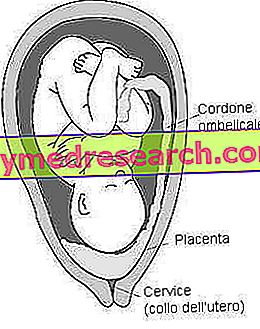Symptoms, signs and complications
To learn more: Symptoms Placenta Previa
The only characteristic symptom of placenta previa is vaginal blood loss ( hemorrhage ), which begins in the second half of pregnancy.

In reality, other symptoms and signs may also occur, but these, unlike vaginal bleeding, occur in a small minority of cases and are episodic.
Therefore, bleeding can be added:
- Ache
- Uterine contractions
- Fetus in transverse or oblique position
BLOOD
Blood loss from the vagina is deep red and painless. It starts from the second half of pregnancy, usually after the 28th week. The onset is sudden and, in some cases, intermittent, meaning that it stops for a few days before resuming. The quantities of blood lost are variable, sometimes large and sometimes modest.
Hemorrhage can be considered the only sign of placenta previa, since it is the only one always present in patients.
OTHER SYMPTOMS
Pain arises when a placental abruption is associated with placenta previa. This combination occurs in about 10% of cases. Pain is a characteristic sign of placental detachment.
| Differential diagnosis between placenta previa and placenta detachment normally inserted | |
| PLACENTA PREVIA | DETACHMENT OF PLACENTA |
| Discrete or abundant external bleeding | External bleeding that may be minor |
| Always bleeding bright red blood | Bleeding always of dark red blood |
| Absent or poor pain | Very intense pain |
Uterine contractions appear in about 25% of cases. They resemble those of labor and last for a few days.
The poorly positioned, transverse or oblique fetus is typical of a good 15% of cases.
THE FETUS
As long as the conditions are stable, the fetus is not particularly disturbed. Fetal distress, in fact, appears when complications arise.
What is fetal distress?
Fetal distress is a vague term that identifies a number of different disorders, including cardiac anomalies, reduced intrauterine growth and oligohydramnios .
COMPLICATIONS
Women with placenta previa must be followed carefully, as there is the possibility that the loss of blood increases to the point of putting them in serious danger.
But on what occasions can this deterioration occur?
An enormous increase in bleeding may occur during labor, at the time of delivery or a few hours after birth. In these situations, medical personnel must be prepared, as the expectant mother is at great risk of hemorrhagic shock (or hypovolemic shock ) and needs an immediate blood transfusion .
Furthermore, conspicuous blood loss can also occur when the pregnancy is not completed. The consequences, in these cases, also affect the health of the fetus, not only of the mother. In fact, the so-called condition of fetal distress can be created and the need for the child to be born prematurely, by caesarean section .
WHEN TO REFER TO THE DOCTOR?
A pregnant woman, who is prone to blood loss in the second half of pregnancy, is advised to consult her gynecologist. If the bleeding is of considerable magnitude, one must not delay in doing so, since it is an emergency.
Diagnosis
The diagnosis of placenta previa is based, in the first instance, on a gynecological clinical examination and, secondly, on instrumental examinations ( ultrasound and nuclear magnetic resonance ).
GYNECOLOGICAL CLINICAL EXAMINATION
The doctor investigates the origins of the bleeding:
- What week did it occur?
- What color is blood?
- Is it conspicuous? Is it intermittent?
These are the key points of the investigation.
Abdominal tests are also performed to check the consistency of the uterus, and vaginal ones are avoided, as they could worsen the bleeding.
Finally, it is possible that the specialist performs the so-called Leopold maneuver, to understand the orientation taken by the fetus in the womb. As you recall, a small percentage of placenta previa cases present with a fetus in a transverse or oblique position.
ULTRASOUND
Ultrasound is the diagnostic test of choice, to confirm suspicions of placenta previa. However, for some pregnant women, the revelation is random, following a normal routine check.
Even more clear information is obtained if transvaginal ultrasound is added to the classic abdominal ultrasound, in which a very small probe is inserted into the vagina. In these situations, the specialist takes the utmost care not to cause blood loss from the vagina.
The examination is reliable if it is carried out between the second and third trimester of pregnancy (see the in-depth study on false positives).
False positives
There are situations where, based on the ultrasound results, one mistakenly thinks of a placenta previa case.
For example, the first ultrasound checks (those carried out in the first half of pregnancy) could show that the placenta is positioned at the cervix. In reality, these are not reliable and definitive images, since, from the second trimester onwards, the fetus and uterus grow and the placenta moves accordingly.
Another circumstance, much less common than the previous one, is linked to the bladder and the possibility that this, if filled with urine, compresses the uterus, changing (only in appearance) the anatomy. The placenta therefore appears to be poorly positioned, but in fact it is not.
NUCLEAR MAGNETIC RESONANCE
It rarely takes place and also helps to understand the exact position of the placenta.
Therapy
When we talk about placenta previa therapy, we refer to those countermeasures that aim, in the less serious cases, to complete the pregnancy without complications and, in the most serious cases, to save the life of the mother and the fetus.
In light of this, the therapeutic path must consider the following factors:
- The position of the placenta in the cervix
- The severity of the bleeding and its modalities (for example, if it is intermittent or continuous)
- Week of pregnancy
- Mother's health
- Health of the fetus
Based on these fundamental points, we act accordingly.
THE PLACENTA POSITION
If the placenta previa is classified as grade I or grade II, a vaginal delivery is performed.
This is the line taken, in general, in these situations. However, each patient is a case in itself and should be treated accordingly. For example, it may happen that a non-serious condition of placenta previa occurs with an intense blood loss, such that caesarean section is required.
If, on the other hand, the placenta previa is grade III or grade IV, you always opt for a caesarean section. In this regard, the following rule applies: if the placenta is placed less than 2 cm away from the opening of the cervix, proceed with the cesarean section.
WHEN THE BLOOD LOSS IS MINIMUM OR ABSENT
If bleeding is poor or absent, the patient does not need hospital assistance or even hospitalization. The only recommendation she is given is to stay at rest and avoid sexual intercourse and most physical activities. If things remain this way, expect the conclusion of the pregnancy: vaginal delivery, for grades I and II; Caesarean section, for grades III and IV.
WHEN THE BLOOD LOSS IS CONSISTENT
Faced with a substantial blood loss, urgent action must be taken and the possibility of a premature birth, as well as a hysterectomy (removal of the uterus) must also be considered.
They are fundamental:
- Hospital admission, to monitor the patient
- A blood transfusion, even a large one, if the bleeding is significant
If we do not act in a timely manner, the situation, as we have seen, can become even more complicated: shocks appear, to the detriment of the pregnant woman, and fetal distress, to the detriment of the child.
Premature cesarean delivery | |
Condition | How do you act? |
| Severe bleeding, but controllable | Before surgery, corticosteroids are administered to the mother to help the growth of the child's lungs |
| Severe and non-stop bleeding | We must work urgently |
Prognosis and prevention
The prognosis, for a woman with placenta previa, is different depending on the case considered and depends on, at least, two factors.
- The first factor concerns the degree of severity with which the disorder occurs. A placenta previa of I or II degree has a minor negative impact on the health of mother and child, compared to a placenta previa of III and IV degree. What makes the difference are the methods of childbirth: risks and consequences (for example, hysterectomy), related to a caesarean section, are more than those of a vaginal birth.
- The second factor concerns the quality of care received by the mother. If the diagnosis is early and the treatment is timely and appropriate (immediate transfusion, correct delivery, etc.), the prognosis tends to be positive, at least for the expectant mother.
CAN YOU HAVE OTHER GRAVIDANCES?
Provided she has not undergone hysterectomy, a woman who has had placenta previa may have other pregnancy. However, it is absolutely recommended to contact your gynecologist, who will assess the situation and tell you how to behave
PROGNOSIS FOR A PREMATURE FETUS
It has been observed that the child, born of a woman with placenta previa, is more likely to develop:
- Sudden Infant Death Syndrome
- Growth delays
- malformations
- Delays in neurological development
NB: we are talking about a higher than normal risk, not a certain and natural consequence.
PREVENTION
Although there is no specific preventive measure, limiting risk factors (for example, not smoking and not using cocaine) is the best behavior to reduce the chances of developing placenta previa.



